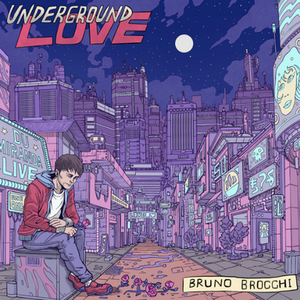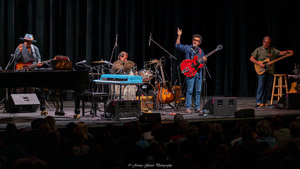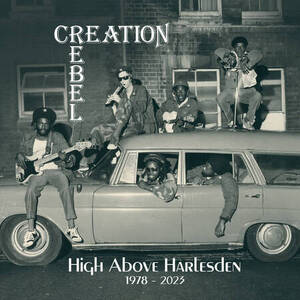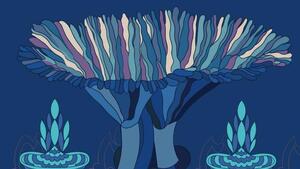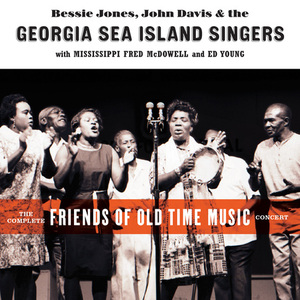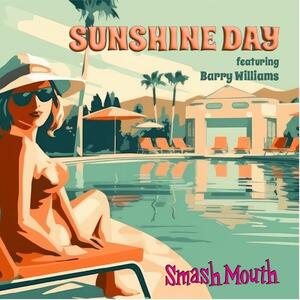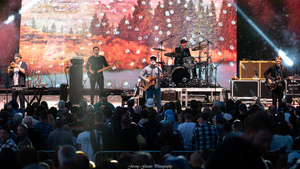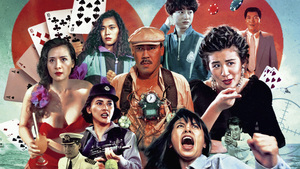Just Because: An interview with Jane’s Addiction Drummer
Stephen Perkins
Part 2
Gail Worley
Note: This is the second part of a two-part interview. You can view the first part here.
• •
“perkins3”
You’re notorious for changing your drum set up – sometimes you have lots of percussion or you have odd sizes of drums mixed together, or bongos instead of toms. Other times you’re playing just a scaled down kit. How do you go about choosing and constructing your set up for different situations?
It all starts with being in the studio. I like to strip down for each tune and try something fresh, and then come back up with a new kit for each song. Taking that into an interpretation of the live show, I think it’s important to have the basic four piece – kick, snare, tom and a floor tom – and from there I like to decorate. People think I have things placed in weird spots, but I’ll always have a 10’ or a 12’ right in front of me and a 14’ or a 16’ as a floor. I’ll have that as my basic [set up] and then I’ll throw a bongo over there, a timbale here and an 8-inch on my right, a 12-inch on my left. To me, it’s just a way to express myself on the instrument. I don’t have to be a guitar player, where the strings have to be in the same place every time. I feel like there’s a freedom to the drumset, there’s a reason you can move things around. I take that to the extreme.
Also, I like to play a tom like a ride cymbal, a bongo like a floor tom, and sometimes by just throwing it up there, it opens up things for me. I’ll think, “Wow, if I put a snare where the floor tom would be and the floor tom over there next to the hi-hat, what kind of beats I could come up with?” All of a sudden, I’m looking at these new beats that I would never really just happen to fall upon, unless I moved the drums around.
Then I get used to it, I start playing that way, and it becomes my sound for the next six months • with timbales and snare drums and ice bells. Then I’ll think, okay, I’ve done that, I’ve really captured that frequency and I’ve written songs with those sounds. Now let’s write some songs where I put the floor toms everywhere, and big 24-inch ride cymbals, and I’ll just play big and…simple. I’ll get into that for the next four months and write songs that way with the guys. That way, looking back, I’ve got a nice colorful spectrum of musical drum parts, different sounds, and different ideas. The drumkits themselves are forcing me to change and by me changing the drumkits… well, it’s a friend of mine. I have to change it to make it change me. I want it to excite me, so, how do I excite myself with this drumkit? Well, I’ll try something unusual. I’ll put two bass drums up – I’ll actually be a double bass player for a while, with an 18” on my left and a 22” on my right. I’ll see what I think of then.
This just continues and it’s just an endless expression. I love watching Terry Bozzio’s drumkit stretch and get bigger – I love watching it change. It’s fun to have the same kit for ten years, but I think it’s inspiring to change it around. I’m always looking at catalogs, thinking, “Oh that’s an interesting thing, you can put a tambourine on your floor tom. I’m going to order that.” or “This looks cool, I could put a shaker on my beater, or I could put a rattle on my…” you know, what ever it is. I like checking all that stuff out to see if it triggers something in my head, to come up with something new. When the guys give me a song, when we’re writing, and I set up my drumset completely different than I did on the last song, I sound like a different drummer.
Now, with electric drums, you don’t even need to place drums; you have one pad and a nice drum brain and you can have a whole selection of drum sounds. I do like to have a couple of electric pads around me at all times in the studio. Sometimes you don’t use them on a song – it’s not called for – but here comes the bridge, and I’ll find an 808 sound in the drum brain, and pop it on the bridge. Either people will look at me and go, “What the fuck are you doing?” Or they’ll go, “Cool man, you’re gonna do that? I’m gonna try something like this on the guitar.” And we’ll just work off each other, but someone’s got to throw something into the mix. So I start with a four-piece drum kit, and then just decorate around it.
Sometimes the drum parts you write sound like more than one drummer is playing, but I know it’s just you, and you can also pull that off live. How do you do that?
It’s a polyrhythm, I guess; polyrhythms with the bass player, with the phrasing of the guitar player and the vocals. I find that, if I focus in on one guy and play to him the whole song, it’ll be a very one-dimensional drum part. But if I focus on everybody and [start with] the bass line, I’ll come up with a rhythm to play with the bass player. Then I’ll stay with that rhythm. Then, here’s the guitar part, and his rhythm’s a little different, so don’t forget to accent a couple of those ideas with Dave, while keeping the other rhythm going with Chris. And now, here’s Perry, and he comes in and just dances on top of the whole thing. He doesn’t really listen to the ones or the fours. He’s just phrasing himself where he likes. He’ll sing a long note, and he’ll go over the piece, then come and sing with some short ones, real percussive, so I’ve got my eye on Dave and Chris, doing that, and there goes Perry.
I have a lot of jobs to do. I have a pulse I have to keep – so people can feel the pulse – but I also have a job to follow everybody’s theme and their little motif and melodies. If Perry says something real important, I’ll go and chase his lyric for a while, then I’ll go back to what Chris is playing, then I’ll notice Dave’s got this riff that’s kind of standing out, and I’ll follow him. So, I am orchestrating the drumbeat as I go. I’m not just playing a solid backbeat, but I am implying the back beat at all times. Implying there’s a simple beat there, but playing around it and then definitely using the bass line, the guitar part, and the vocal part as percussion, and playing around that. Everybody’s got a place and I shake a little salt on Perry and I shake a little salt on Dave here and there, and everyone gets it at a different time. As I chase around everybody, it gets them to fit to the grooves that I don’t use. So yeah, there are a lot of polyrhythms, with my hands and my feet and with the other members. The most important thing is to never lose touch with the pulse that makes you shake your ass, basically. I think it’s important to play the basic drum beat, when the song needs a lot of space, but sometimes I think the song needs to be a little more interactive and a little busier, and that’s when I’ll start going off a little. I think that’s what you’re hearing as more than one rhythm.
That’s really amazing.
Let’s look at the rhythm in “Mountain Song”; the bass is [sings bass line]. He doesn’t leave much room for me, because he’s playing every note. But I know there is room for me, so while he’s doing that I go [sings drum riffs] and I play between everything. All of sudden, he’s got a rhythm and I’ve got a rhythm, so it sounds like there’s two or three rhythms happening. I keep my hi-hat going the whole time – so there’s another rhythm. Then Perry’s percussive vocals and Dave’s rhythms [come along]. It takes a good ear to understand Jane’s Addiction sometimes because maybe it sounds like a lot to digest, because there are so many polyrhythms, especially live. Live, we all really start working off each other, and it’s not as tame or as controlled as a studio environment.
You’ve played with some pretty phenomenal bass players, where there’s just some sick grooves going on. Do you have a favorite bassist to play with?
Everyone’s got his spot, for me. From playing with Eric, when I was eighteen, I think he’s formed more of my sound than any other bass player. Eric helped me find my sound and let me become my own drummer, more than anybody else. Then playing with Flea is like playing almost with a mirror. He is so dead on with my hands. [imitates Flea’s playing style] That’s like riding a roller coaster. So, Flea is like a roller coaster, and Eric is more like a couch. It just fits and I can do anything on the couch. On the roller coaster, sometimes you’ve gotta hold on!
Martyn, being from Europe – he’s from Amsterdam – grew up on a different type of music. American rock music was so important to me, but growing up in Amsterdam, he said he heard a lot of European pop music and stuff that I never heard of. His whole approach was very different and that was quite exciting and quite inspiring. Like, the beginning of the song “Meija” is real Latin and kind of round, and then it goes into this winged feel. But whatever it was about the way he played it, it just seemed fresh to me. Martyn was real fresh and he had this great European sensibility, which was odd, and very different.
I’ve been very, very fortunate to play with Mike Watt over and over. Mike Watt is like… no other. Playing with Mike is like wrestling with somebody, because he grabs onto you and you feel the pressure of the grip, and you’re both moving each other in certain directions, you’re tugging. Mike Watt is probably one of the most exciting bass players and most punk rock players ever. “Punk Rock” meaning that if anything’s going normal and it feels comfortable, he’ll throw a wrench into it. That’s the real Punk Rock attitude. If the scene is heavy metal, then play acoustic songs – that’s punk rock. That’s his attitude, so when you’re on stage and you’re feeling that everything is comfortable with Mike, he’ll start blazing in the other direction to make sure you’re listening. Watt is like a punk, at all times. [Laughs] I love playing with Watt, for that reason alone, but besides that, he’s a great guy.
In Banyan I played with Rob Wasserman, who plays an upright, six-string fretless. He’s got more of a double bass or cello approach, and that sends me to a whole other place. I tend to do less bass drum work and more textures when I play with Rob, because he covers so many bases with a six-string fretless. There’s so much going on, I let him lead and get my bearings behind him.
Now we have Chris Chaney, our new bass player. He’s almost like a John Entwistle, where he just completely takes you on a ride. It’s tough and melodic and just demanding of your ear. You might think, “What the hell is he doing? That’s insane!” Wow! That’s what I hear on his bass parts, and it’s a great idea. It’s tough like a wild tiger running out of its cage, but it’s still got a really important melody. He knows what Eric did, he plays the songs live, but he’s not Eric and he’s not trying to be. He has his own approach, but it’s real melodic and just real tough. It gives me a chance – because like I said, he’s so schooled and technical – to, like in the old days with Eric, go off. I know when I come back he’s going to be right there waiting. It’s just the perfect metronome. I feel now that Chris and Dave are just a perfect match.
Amazing.
At this time, there’s nothing better than Jane’s Addiction [laughs] for me. It’s just the best thing I could do, I’m so happy. The craft behind Jane’s Addiction is so powerful and potent. We think that if made two or three records before; we can do that again, but they’re all going to be better. These are also better times for us. We’re more focused and more controlled.
Also, weren’t there some drug problems going on, back in the day, that maybe aren’t happening now?
Well that’s for sure. We never kept our drug use private. I’ve got to be honest; I was never into that fucking stuff. I couldn’t play the drums and be out of my mind. But it was a sad state and it was the truth of what was happening. Of course, that totally clouds every decision, and we could have still been together if the decisions were made under a better mindset. All that said, everyone is revived and no one ended up in jail or six feet below. A lot of people do when you mess with that kind of toxic lifestyle. There were a lot of bad drugs but there were a lot of good parties, too. But, yeah that’s all behind us. After Jane’s, somebody could have crumbled. Thank god the guys are obsessed with other things: working out, being healthy, doing good things for the environment and writing good songs. Those fuckers are healthy now and focused. Decisions are focused and clear, and what we want to do with our career is clear. Looking back, it’s pretty cool. We took twelve or thirteen years off and people are ready for it. It’s not like we’re a burn out band from the ’80s. We’re a real fucking band. Our music’s relevant, the lyrics are relevant, the sounds – sonically – and the players, everything is relevant, again. It’s a wonderful time.
I never asked you, when did you start playing drums?
I started playing drums at eight, and I got my first drumkit when I was thirteen, the day after my Bar Mitzvah.
Mazel tov!
Thank you! At first I played pillows, you know, for a couple years…and I thought I was serious… but I guess I was serious at thirteen.
Like the commercial on VH1 Classic, where the kid is playing pillows to “In the Air Tonight”?
Exactly! At fourteen or fifteen, I met Dave and I thought he was the best guitar player there was. At that age, I thought, wow, we’re going to be famous! That’s why we look back and laugh, because it’s pretty funny. We played together at fourteen years old… and we still are. And Perry’s got a whole other vision of music that Dave and I didn’t have; growing up with Sly Stone, and he actually saw Led Zeppelin and The Who. All that stuff [laughs], that’s kind of cool. Our record collections are completely different. If I go into Perry’s car, he’ll have a couple of electronic records and maybe an African record. If I go into Chris’s car, he’ll have some Jeff Buckley, some real serious fucking playing. Then I’ll go into Dave’s car and its Nine Inch Nails, for sure. In my car maybe there’s some Bad Brains and punk rock, Iggy and the Stooges. Everyone’s got their own flavor and you bring it to the table. I’m sure everyone in Metallica’s got different records, but sometimes you wonder because it’s hard to hear many influences… not in Metallica but in the music today, that’s come out after Metallica. You know, today a thousand bands sound like Metallica.
It’s said all the time to me, how it used to be that people got into bands because they wanted to create something new. Now everyone starts a band because they all like Pearl Jam or they all like Blink 182. Case closed.
We’re big fans of the Grateful Dead, not only their music but their attitude and what they did with their fans. It wasn’t about the record sales; it was the culture, the scene. Show up in the parking lot and there’s drum circles, there’s people camping out. Jane’s always had that, and we’re hoping to bring it back. I guess our scene is a little more alternative and hard rock, but I feel like it’s great to have a band that you can go and spend the day with instead of just showing up at nine and going home at ten fifteen. That’s what Lollapalooza’s going to bring.
“perkinsLee”
Some people might not know that you were Tommy Lee’s drummer for Methods Of Mayhem. What did you enjoy most about working with Tommy on that project? Is it true that you used to help him set his drums up back in the early strip metal days of Motley Crue.
Well, see, Tommy doesn’t remember that, but it’s true. During Jr. High, my friends and me went to, like, 45 Motley Crue shows. This was before Too Fast For Love, before anything. I would show up [at the club] at two or three in the afternoon, before Tommy or the band would get there, and I’d talk to the drum tech. He’d be like [imitating stoner dude voice], “Yeah dude, give me the snare stand out of the case,” and I’d go get the snare stand. “Hey go get the cymbals and shit.” So Tommy, he didn’t know. But, when I finally did join Methods, I brought a couple photos of myself with Tommy in the background. I’m like this young, little kid with an afro and braces, and Tommy’s in the background looking so cool. And I’m like, “Dude, that is me.” And he’s like, “What? No way!” He couldn’t believe his eyes. I was a huge fan and I still am. I think Tommy is the fucking greatest, he’s a great musician, he’s the shit. He’s so focused on his music and he’s so into it.
How’d you get that gig?
Basically, I heard he was looking for a drummer. I called him and asked him, “What’s the deal?” He told me that he was singing and playing guitar. So that was it, I heard the record and said, “I’m in if you want me. Let’s do this.” We started working together, and the best part of it, besides being Tommy’s drummer – the back beat of his new band, because I knew how important the drums would be – was that I got to play with the guy every day. We put together a drum solo, which we started the show with. Rehearsals started at two so we’d get there at twelve and work on the drum solo for two hours. We’d rehearse until 10:00 PM and stick around until Midnight and laugh and play drums… it was just a great scene. He really brought me to a new level, as far as drumming. I had to learn his beats, his pocket and it was really serious. It was a really serious job, but the most fun part of it was just hanging out with Tommy everyday. He’s just a fun guy.
It was just awesome because I grew up with Motley Crue, and knowing Tommy’s beat. Now, watching him play is fucking sick, he can really fucking play those drums. Of course, when you’re playing with Tommy Lee, all the greatest drummers come down and check out what’s going on, like Carmine Appice, Matt Sorum, Dave Grohl, and Greg Bissonette. Everyone kept showing up at the studio, “What’s going on down here, dudes!?” It was just a good hang.
Tommy definitely brought me to a new level on the drums. We spent a lot of time with the electric drums and working with loops and click tracks live and all these different sequencers. That was a great education as well. Tommy’s really up on all the stuff that, sometimes, I shy away from. I like the electric drums, but I’m more into the acoustic drums. He’s got the electric drums down to exactly what sounds he needs, how the dynamics work, how to get the best thing out of a PA, what frequency to tune in. It was exciting, I learned a lot from him.
Jane’s Addiction: http://www.janesaddiction.com ◼

